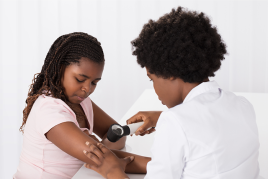Epidermolysis bullosa: Who gets and causes
Who gets epidermolysis bullosa?
EB is rare. It is estimated that between 25,000 and 50,000 people in the United States have EB1.
When a person has EB, the different layers of skin slip and slide against each other because the skin lacks the proteins needed to hold each layer in place.

Most types of EB begin in childhood. The fragile skin and blistering of EB are usually noticeable at birth or shortly thereafter. If a child has a mild case of EB, the blisters may begin when the child starts to crawl. Only one type of EB, epidermolysis bullosa acquisita (EBA), begins in adults.
A child has a higher risk of developing EB if one or both parents carry genes for EB.
As for race, EB develops in children of all races and ethnic groups.
What causes epidermolysis bullosa?
No type of EB is contagious. All but one type, epidermolysis bullosa acquisita (EBA), are caused by gene mutations. A mutation creates a slightly different version of a gene.
When a child has EB, these slightly different genes mean the skin is missing the proteins needed to hold it together. Without these proteins, a gentle touch can cause the layers of skin to slide against each other, creating friction. It’s this friction that causes blisters to form.
While a gentle touch can cause blisters to form, that’s not the case for everyone who has EB. The type of EB a person has determines how easily the skin blisters.
When a child develops blisters in other areas, such as the mouth, throat, or rectum, it means that these areas are also missing the proteins that hold these layers together.
The cause of EBA is a bit different. It’s thought that this type of EB is an autoimmune disease. When someone develops an autoimmune disease, the person’s immune system mistakes a part of the body as foreign and attacks it.
When a person develops EBA, the body is attacking and destroying the proteins that hold the layers of skin together.
Genetic counseling can identify EB genes
Because EB can be such a painful and often disabling disease, people living with EB or who have EB in their family often want to spare their children from getting it. Genetic testing can tell you how likely it is that you will have a baby with EB. Testing can take several months, so it is best to do it before trying to have a child.
It’s also possible to tell if a baby growing inside its mother has EB; however, this test can be risky for the baby.
1Stanford University, Stanford Children’s Health. “FAQ about epidermolysis bullosa.” Last accessed July 2018.
Image
References
Kudva P and Jain R. “Periodontal manifestation of epidermolysis bullosa: Looking through the lens.” J Indian Soc Periodontol. 2016 Jan-Feb;20(1):72-4.
 Molluscum contagiosum: How to safely treat it
Molluscum contagiosum: How to safely treat it
 Biosimilars: 14 FAQs
Biosimilars: 14 FAQs
 Practice Safe Sun
Practice Safe Sun
 Relieve uncontrollably itchy skin
Relieve uncontrollably itchy skin
 Fade dark spots
Fade dark spots
 Untreatable razor bumps or acne?
Untreatable razor bumps or acne?
 Laser hair removal
Laser hair removal
 Scar treatment
Scar treatment
 Botox
Botox
 Free materials to help raise skin cancer awareness
Free materials to help raise skin cancer awareness
 Dermatologist-approved lesson plans, activities you can use
Dermatologist-approved lesson plans, activities you can use
 Find a Dermatologist
Find a Dermatologist
 What is a dermatologist?
What is a dermatologist?